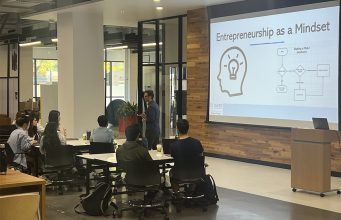 Meera Shankar, India’s ambassador to the U.S., recently delivered the keynote address at Emory University’s Emerging India Summit, offering a panoply of reasons for why India matters—to the U.S. and to the global economic order. It is the world’s largest democracy, with an electorate of more than 700 million people, a rapidly expanding market, a land of astonishing diversity and enterpreneurial energy, and the world’s second-fastest growing economy. “India is confident and aware of its capabilities,” says Shankar. “Our key national priority is to have sustained rapid and inclusive economic growth while ensuring that the fruits of our economic development reach all sections of society.” Quoting U.S. President Barack Obama, Shankar emphasized that “increased economic interaction between India and the United States can be a win-win proposition.”
Meera Shankar, India’s ambassador to the U.S., recently delivered the keynote address at Emory University’s Emerging India Summit, offering a panoply of reasons for why India matters—to the U.S. and to the global economic order. It is the world’s largest democracy, with an electorate of more than 700 million people, a rapidly expanding market, a land of astonishing diversity and enterpreneurial energy, and the world’s second-fastest growing economy. “India is confident and aware of its capabilities,” says Shankar. “Our key national priority is to have sustained rapid and inclusive economic growth while ensuring that the fruits of our economic development reach all sections of society.” Quoting U.S. President Barack Obama, Shankar emphasized that “increased economic interaction between India and the United States can be a win-win proposition.”
India, capitalizing on expanding domestic demand and an increasingly skilled, innovative workforce, is poised to become an anchor of stability and opportunity in the global economy.
“The choices that Indians make or do not make, the products they consume, the ideas they embrace will not only have significance within India but in the wider world, ”says Meera Shankar, India’s ambassador to the U.S.
Speaking at the recent Emerging India Summit held at Goizueta Business School and Emory’s School of Law, Shankar discussed “Why India Matters” in her keynote address exploring the country’s demographics, strategic alliances, market potential and workforce development. Other speakers at the two-day event, including Benn Konsynski, George S. Craft Professor of O&M; Jagdish Sheth, Charles H. Kellstadt Professor of Marketing; and Vivek Wadhwa, Distinguished Visiting Scholar for Emory’s Halle Institute, reflected on India’s comparative economic advantages and disadvantages, military strategies, market innovations and the future of Indo-U.S. relations.
“India is defying gravity and becoming a global R&D hub,” says Wadhwa. “Its entrepreneurs are beginning to build world-class companies with innovative breakthrough technologies.”
Organized by the student-led Emerging India Forum, the Halle Institute, and Goizueta and Emory College faculty, the summit strengthens Emory’s brand name recognition in India while encouraging dialogue on campus about Indian affairs.
India’s Growth Story
If India’s current growth rate continues, income levels will nearly triple and India will represent the world’s fifth-largest consumer market by 2025, says Shankar, citing a recent McKinsey & Company study.
“Businesses that can meet the needs of India’s aspiring middle class, keep price points low to reflect the realities of Indian incomes, and adapt to the fast-changing market environment will find substantial rewards in India’s rapidly growing consumer market,” she adds.
India’s cellular phone market, for instance, has exploded over the last decade to nearly 800 million subscribers, penetrating remote areas and lowering customer costs. Through cyber kiosks, farmers can now research weather information and evaluate produce prices in local markets.
The services sector has propelled India to become a solutions hub, a base for conducting sophisticated R&D and technology innovation, notes Shankar. Indian pharmaceutical companies are providing affordable vaccines, and telemedicine allows patients from every corner of the world to access top-notch medical facilities.
The multinational IT sector has effectively leveraged India’s large pool of skilled workers to increase profitability and competitiveness, she continues.
At the same time, India has an increasing stake in ensuring a stable global order.
“We see our relationship with the U.S., which is one of our largest trade, investment and technology partners, as a vital element of our endeavor to transform our socioeconomic conditions,” Shankar says. “The highly successful visit of President Obama to India last November has significantly expanded and deepened our cooperation.”
Similarly, both countries have committed to improving agricultural productivity in several African nations. Nourishing the Indo-U.S. relationship are the nearly 3 million Indian Americans who serve as an important bridge, Shankar says.
India in 2025
Sheth notes that India’s impressive growth record will not only provide burgeoning consumer markets but will also expand the country’s significant role as an economic engine and geopolitical player by 2025.
Some of the largest global enterprises will be of Indian origin, predicts Sheth, including basic industries such as copper, steel, aluminum, and cement. This will be accomplished not by exports but through large global acquisitions.
Second, India will become the second-largest consumer market in certain products and services, such as motorcycles, appliances, beverages, and agricultural and dairy products, surpassing the U.S., Japan, and Germany.
Citing India’s business dealings with Bolivia, Peru, Iran, and other countries, Sheth expects that India will continue to “partner with strange bedfellows in search of industrial, agricultural, energy, and talent resources around the world.”
Challenges Ahead
India’s vibrant secular democracy and development go hand in hand, Shankar says. Rather than adopt an export-driven strategy, the country has benefited from rising urban and rural incomes and a sharp increase in savings and investment rates.
“Today, the fact that we have a woman head of state, a Sikh head of government, and a Muslim vice president is perhaps the best statement of the multi-ethnic and multi-religious nature of our state,” she says.
When India gained its independence in 1947, two centuries of foreign rule had reduced the country from one of the world’s largest economies to one of its poorest. Today, a large percentage of the population continues to live below the poverty line, and agricultural incomes are not keeping pace with other economic sectors. The agriculture industry employs more than half of the population, but only generates 16 percent of the GDP.
With the majority of India’s population under age 65, it is estimated that the country will require an investment of nearly $1.7 trillion over the next decade to upgrade public infrastructure and educational and training facilities, says Shankar.
“This represents a huge opportunity for our international partners,” she adds.
Mark Twain once described India as the “cradle of the human race, the birthplace of human speech, the mother of history, the grandmother of legend, and the great-grandmother of tradition.”
“Allowing for some literary exaggeration,” says Shankar, “he got the big picture right.”
RELATED CONTENT:
CNNMoney: India Won’t Outpace China without a Few Miracles
Financial Times: Powerhouse Economies Lure Staff
Emerging India Summit: Video of Panel on India’s Regional and Global Challenges
Emerging India Summit: Video of Lecture on Future of Indo-U.S. Cooperation










